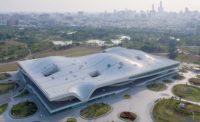Heidelberg, Germany
Completion Date: October 2010
Total construction cost: $35 million
Gross square footage: 141,000 gross square feet
People
Owner
Architect:
Personnel in architect's firm who should receive special credit: Project leader: Andreas Hardegger Architect of record: Behnisch Architekten, Stuttgart Interior designer: Behnisch Architekten, Stuttgart
Engineer(s):
Consultant(s) Lighting: Belzner Holmes LDE Acoustical: ITA Ingenieurgesellschaft für Technische Akustik mbH Other: Medicine technics: woernerundpartner planungsgesellschaft mbH
General contractor: for concrete superstructure:
Photographer(s)
CAD system, project management, or other software used: |
Products
Exterior cladding Aluminium/ Wood/ glass curtainwall: rossmanith fensterbau GmbH & Co.KG Concrete: Leonhardt + Weiß
Roofing Other: Green roof: Essenpreis Holzbau und –bedachungen GmbH
Windows Aluminum: rossmanith fensterbau GmbH & Co. KG
Glazing Skylights: rossmanith fensterbau GmbH & Co. KG
Doors Wood doors: Internal doors: Strähle Raum-Systeme GmbH / Ohning Innenausbau GmbH Fire-control doors, security grilles: Ohning Innenausbau GmbH
Hardware Cabinet hardware: Wesemann GmbH Laboreinrichtungen
Interior finishes Cabinetwork and custom woodwork: R & M Ausbau Mannheim Paints and stains: Coloris GmbH Special surfacing: T & M Ausbau Mannheim Floor and wall tile: Fliesen Krause Resilient flooring: raumstudio falter GmbH & Co. KG Carpet: raumstudio falter GmbH & Co. KG Raised flooring: raumstudio falter GmbH & Co. KG
Furnishings Chairs: Hussl, Arper, Casprini, OKA, Bimos Tables: Viasit, FormVorRat
Lighting Exterior: Bega
Conveyance |












